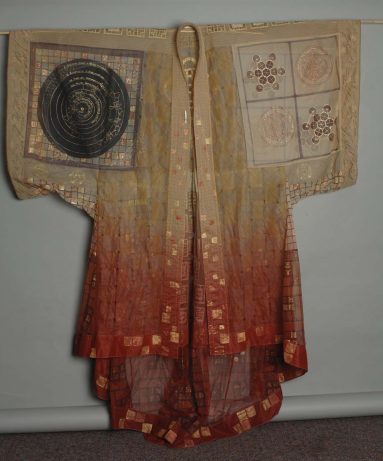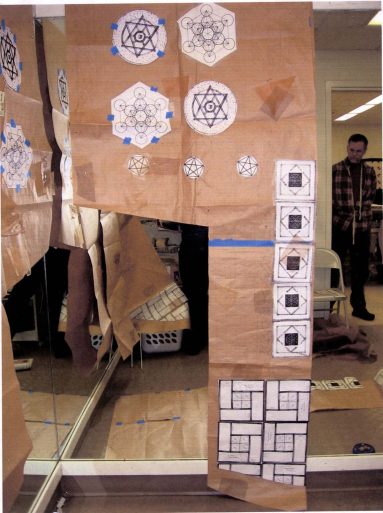Process: Prospero’s Magic Cloak.
“The Tempest.”
Oregon Shakespeare Festival 2007
Director: Libby Appel
Design: Deborah Dryden
Photos by Jenny Graham
Fabrication by the artisans of the OSF Costume Shop
with Lead Dyer Painter, Chris Carpenter.
Read About the Process: Scroll Down or Click Here
The inspiration for this cloak originated from a 15th c. talismanic shirt found in the Topkapi Museum in Istanbul. Talismanic shirts were frequently worn under armor and were designed to protect the wearer from evil spirits. The incorporation of writing and symbols on these garments invoke spiritual power and are reminiscent of the delicate ornamention of medieval manuscript illumination.
While traditional talismanic shirts are Islamic in origin, I was interested in depicting a more universal variety of symbols and iconography that reflect diverse belief systems. Symbols, such as the hexagram or the pentad, are utilized in many different cultures’ spiritual beliefs. Images were drawn from Divine Proportion found in nature and the “celestial alphabet”,as were symbols used in witchcraft and alchemy. Invented calligraphy decorate the borders of the sleeves.
Larger circular imagery apparent on the sleeves represent Copernicus’ 16th c heliocentric model of the solar system , with which Shakespeare was undoubtedly familiar.
We chose to create this garment out of sheer fabric dyed multiple related hues of old parchment, ombréd in its final iteration in red dye. Nylon organdy was chosen as the fabric, chosen for its dye-ability and its strength. The garment needed to be durable enough to withstand the rigors of multiple performances in an outdoor theatre subject to inclement weather. Aesthetically, I was interested in the use of the sheer fabric to allow the images to interact with one another as one image would be seen through to another on the reverse side of the garment.
Early in the design process, I realized that, in order to accomplish this complicated piece in the allotted time, I needed to design the garment in such a way that parts of it could be worked on by different areas of the workroom. This led to creating the garment in sections. While some aspects were “woven” and stitched in the workroom, other parts could be dyed and painted simultaneously in the dye/paint area. Finally, the parts were stitched together and the final step was the red ombré .
The robe is a combination of dyed, hand stitched, and woven sections of the sheer, augmented by gold metallic paintwork utilizing hand painting, screen printing and stamping techniques. The center back panel uses motifs created from sections of commercially available fabric. The front edges and the sleeve edges are interfaced with deer netting from a garden supplier. It provided stiffening without detracting from the sheerness of the borders.
We altered the traditional T-shape of the talismanic shirt shape, by adding a large godet centerback to create a more graceful “train” effect in the finished garment.
An identical garment in unpainted nylon organdy was created for fitting purposes and for the actor to use in rehearsal.
Although this garment was only one costume of many, I found that the process of creating this costume proved to be one of the most collaborative projects I have had the fortune to design. Beginning with the initial conversations with the director,Libby Appel, the basic ideas and imagery developed. Derrick Lee Weeden, (the actor playing the role of Prospero) and I had an ongoing interaction regarding which symbols and images might be meaningful as an expression of the character.
The fabrication of the garment itself by the artisans of the OSF costume shop and especially Lead Dyer/Painter Chris Carpenter, was a remarkable feat that depended on everyone’s individual talents and imagination.












